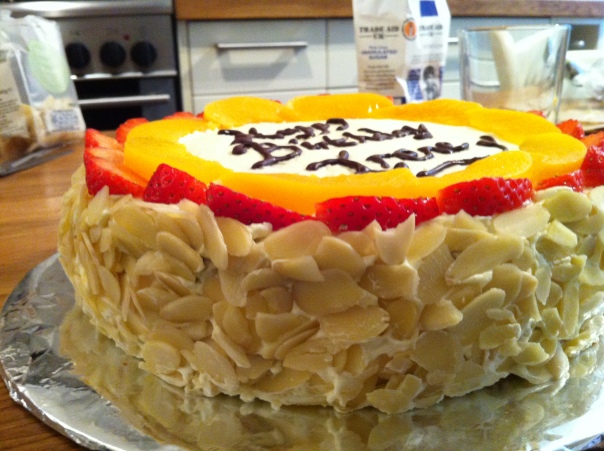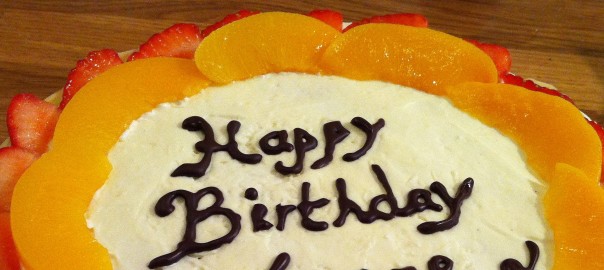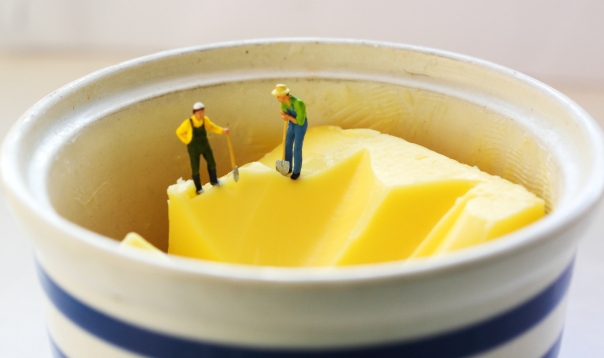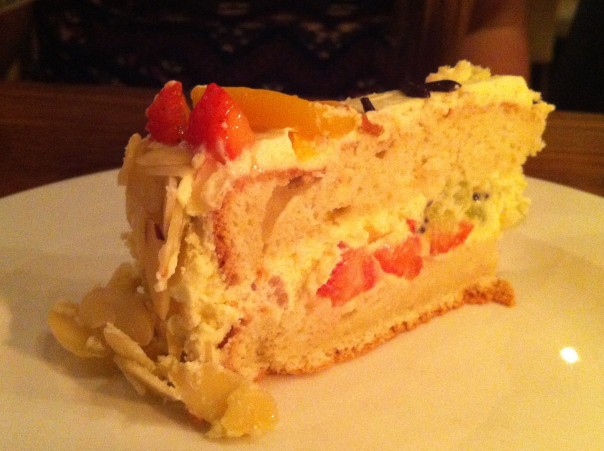…since I last posted anything.
I guess I’ve been pretty busy – I’ve done a lot since I last wrote, including teaching English at an international school, moving countries and starting a PhD. I’m actually sitting in the PhD office right now, looking out the window at chirpy undergrads heading to their lectures. It’s a nice campus, with nice people and I think I’ll be alright. So far, I’ve managed to break through the shy/can’t-be-bothered wall that usually stops me from being sociable and I have to say, I’ve met a nice bunch of people that way.
So, I thought I’d share the recipe for a Chinese/Japanese fruit cream cake that I’ve made a few times. Growing up as a child in a very Asian environment, this cake automatically screams birthday to me. It’s made up of a light sponge, with chopped fruit and cream sandwiched between two layers. Then the entire cake is covered in a light, creamy icing and topped with more chopped fruit; as you’ll see in my pictures, sometimes the sides get a bit more decoration by way of sliced or chopped nuts. There are many variations out there, using different fruit and sometimes flavoured creams, but what I’ve made can probably be regarded as the classic version.
How is this different from a regular cream cake? Well for starters, it’s a lot lighter than the European (and probably American?) equivalents, which generally use buttercream frosting. As much as I adore buttercream frosting, it can get a bit too much after a few slices. There’s also practically no butter (or oil) in the cake batter. I was baking with a friend last week and when I told her we only needed 22 g of butter, she actually stopped my egg-beating and checked – twice. The cake gets more than enough fat and moisture from the syrup layer that we brush on the inner layers of the cake, as well as the cream icing. So fear not, it is definitely not a dry cake.
Now, the whipped cream: you don’t need to worry about the outer cream layer sliding off or melting. There’s a little bit of gelatin added to make it stabilised whipped cream. It’s not so much gelatin as to have a solid jelly icing, but the cream holds its shape much better than a simple cream/sugar mixture, all without the heaviness of a buttercream icing. On that note, I suppose that’s a point for people who don’t eat gelatin – you could try substituting with agar agar flakes, which is made from seaweed, although I don’t know if the quantities would change.
By the way, an important point: please make sure you use double cream, not whipping cream. Whipping cream has a lower fat content and doesn’t hold up quite as well as double cream, even with the gelatin.
Use whatever (soft) fruits you feel like having. I’ve made a version of this cake with strawberries, kiwis and peaches, as well as a strawberry and banana version. More recently, I tried it with lychees and I’ve been contemplating a mango version that may or may not involve mango purée. As for fresh or canned fruit I think either can work and it’s really up to you; I’ve used either as well as a mixture of both with no problems.
So, without further ado, the recipe:
Asian fruit cream cake (adapted from La Fuji Mama)
makes one 7 or 8 inch cake
For the sponge cake:
4 large eggs, whites and yolks separated
120 g white sugar (either castor or granulated)
3 tablespoons full fat milk, at room temperature
1/2 teaspoon vanilla extract
120 g cake flour, sifted three times (plain flour is an adequate substitute)
22 g butter, melted
For the stabilised whipped cream frosting:
1 teaspoon unflavoured gelatin
4 teaspoons cold water
1 cup cold double cream
1/4 cup icing sugar
1/2 teaspoon vanilla extract
For the simple syrup:
1/4 cup white sugar (castor or granulated)
1/4 cup water
~250 g sliced/chopped fruit, to fill and decorate
Chopped or sliced nuts, to decorate
Preheat the oven to 170 to 180 °C. Grease and line a 7 to 8″ cake tin.
Add the sugar to the egg whites and beat till stiff and glossy. Then add the yolks to the beaten whites, gently folding till incorporated.
Add milk, vanilla extract and flour (in that order) to the egg mix and gently fold the ingredients in. Then, add the melted butter, once again gently folding to fully mix the batter.
Pour batter into the prepared cake tin; remove air bubbles by dropping the tin on the counter a few times. Bake for 20 to 25 mins. The cake is done when it is golden and a cake tester comes out clean. Allow to cool on a wire rack.
While the cake is baking, put the cold water in a small saucepan and sprinkle the gelatin over the water. Leave to stand for 5 minutes (do not stir). Then, gently heat the gelatin and water on the stove, stirring with a wooden spoon until the gelatin dissolves. Remove from the stove and allow to cool to room temperature.
Combine the double cream, icing sugar and vanilla extract in a mixing bowl. Whip until the cream is slightly thickened. Then, slowly add the cool gelatin, while still mixing. Finally, whip at a high speed until stiff. Keep cool before use.
For the syrup, combine the sugar and water in a saucepan. Bring the water to a boil, stirring until the sugar dissolves and the mixture thickens slightly. Remove from heat and allow to cool.
To assemble the cake:
Prepare the fruit for decorating and filling the cake. Do not overfill the cake.
Once cool, slice the sponge cake horizontally into two layers.
Brush a layer of simple syrup on the inside of one layer. Then, spread an even layer of cream over the syrup. Place the sliced/chopped fruit over the surface. Spread another layer of cream over the fruit layer.
Brush some syrup over the inside of the other cake layer and place on top of the first cake layer.
Frost the top and sides of the cake with the remaining whipped cream. Decorate as desired with fruit and/or nuts (see my pictures and the link to the original recipe for ideas).

Final step: slice and enjoy, but beware: this cake is so light you might end up eating more than you plan to!



What a lovely bake! Will be looking forward to your next bake!
Thank you! So do I.
Also I saw your Calvin & Hobbes 3D designs and they’re amazing.